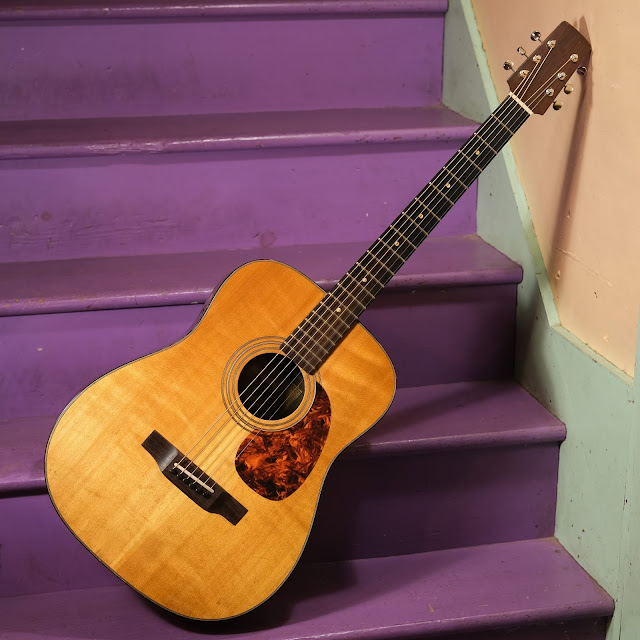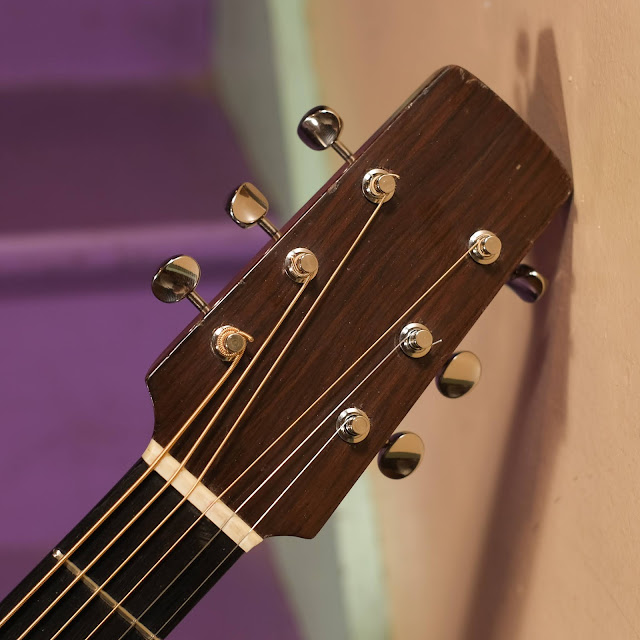2002 Alegre (Philippines-made) FG-A1 Baritone Guitar
Alegre is now a fairly good-sized operation, but back in 2002 when my Mom picked this up for me in the Philippines, I don't think they were well-known outside their region at all. This was my first "real guitar" that wasn't borrowed from my Dad. It positively stinks of oddball, handmade build and it always has.
The body is extremely thin solid rosewood (or very similar to rosewood, anyway) on the back and sides and solid spruce on the top -- with nice silking and light figure to it. It's x-braced with 3 tonebars and the neck is 5-piece with some steel reinforcement as well, but no adjustable truss rod. The neck has a little backbow, but string tension evens it out a lot. Still, it's there a bit, so action is nudged a little higher than normal beyond the 12th fret.
I used it religiously until about 2006, when I was starting to do a lot more beginner/guitar-flipper repair work for myself and starting to acquire other, more practical guitars. By that point it'd been around the block a lot and had sustained neck-joint trauma from harsh Ecuadorian customs agents, a split bridge from dryness, a puncture in the side from carelessness, several terrible DIY pickup installs that left their marks, several DIY tuner installs that left their marks, a couple loose braces, shifting playability, and it'd entered a general state of unhappiness. The finish started looking glorious with all the hot/cold/take-everywhere action it got through college -- it's got checking and nicks and dings and scratches that make it look more '50s than 2000s.
I later gifted it to my cousin but it found its way back after maybe 9-10 years "out there somewhere" via my Aunt. Since then it's sat in my repair racks with a split bridge and bereft of strings and tuners.
I spent some after-hours time this week, however, putting it back to rights. The first thing I did was check out the neck -- and was shocked to find that it has a 27 3/4" scale length, putting it firmly into baritone guitar territory. I never knew that before, because it'd become the "guitar in the corner" so long ago.
Unknowingly, however, I'd been playing it detuned from standard the entire time I was using it, and slapping a capo on when I needed to get higher. I think I had this tuned up E-to-E maybe twice and only for short periods. It was a total bear to play that way. It mostly sat at C# or D below standard or in a detuned open D tuning (C# or C) depending on what I felt like playing on it at the time. I could tell it wanted to be pitched lower than normal.
Repairs were a lot but also not quite that much -- I fixed the neck-block issue and reinforced the top and block area with an oversized popsicle brace. I then reglued some bracing, touched-up a terrible patching job on the side, cut a new bridge for it (with the same footprint as the original) and installed that, gave it a fret level/dress, new tuners, a new pickguard, new saddle (in the right place, finally), new ebony pins, and a setup with 64w-14 baritone strings.
Currently it's tuned to Bb open (like open D dropped low) and sounds glorious.
Oh, and before I forget -- I also shaved the braces inside to get it a bit less stiff-sounding. It worked.
The original bridge was so goofy in profile -- this new rosewood one I made is a heck of a lot more practical and I aligned the pins with the angle of the (steep) compensation it needs for the baritone stringing.
The tuners are new Gotoh Kluson-style units -- note the factory-original uneven spacing...















Comments